
How to fix “bad” dog behavior that has been reinforced?
Sometimes it happens that the dog “badly” behaves, and the owner unwittingly reinforces this behavior. And he notices this only when the bad habit is so firmly entrenched that it seems that it will never be possible to get rid of it. However, the “bad” behavior that you have unintentionally reinforced can be changed. And in humane ways. How? Following a step by step algorithm.

Contents
Step 1: Make Problem Behavior Impossible
Remember the important thing: if the dog does something, he gets something for it, that is, his behavior is reinforced. Behavior that is not reinforced disappears. So, your task is to create conditions when the problem behavior does not bring benefits to the dog. How to do it?
- Create acceptable living conditions for the dog.
- Properly use the opportunity to control the situation (choose the distance to the irritant, use a muzzle or leash).
- It is important to be patient, because the dog, accustomed to the fact that certain behavior brings her bonuses, will try. And still try. It is necessary to follow the rule: never reinforce it again under any circumstances. For example, if you resisted nine times to treat a dog that barks you for food, and the tenth time he still got a bite, then all previous efforts were in vain, moreover, you greatly complicated your task for the future. So never and never. When the dog understands this, he will look for an alternative.
- If necessary, use veterinary drugs (for example, sedatives) – of course, only as directed by a veterinarian.
Step 2: Create the conditions for the desired behavior
- And again, be patient to wait for the moment when the dog can be praised. Remember that the right moment will definitely come!
- Choose conditions in which the trigger (what triggers “bad” behavior) will be minimally expressed. That is, you can work until the dog shows problematic behavior. For example, if the dog is aggressive, choose a distance at which he already sees the object of aggression, but has not yet reacted to it.
- Teach your dog the desired behavior like any other skill.
Step 3: Reinforce the desired behavior
- And again, be patient. This takes time, as you need to reinforce until the desired behavior becomes a habit (and even after that periodically too). And sometimes it is necessary to reward the dog for this or that behavior all his life. Don’t skimp on this!
- Choose the right reinforcement (that is, what the dog really wants at the moment).
- Gradually increase the strength of the stimulus (you can’t force it, but you shouldn’t delay it either).
If we are talking about a puppy, everything will go faster and easier. If you have an older dog, you will need more time. But do not despair! If you feel that you cannot cope on your own, you should seek help from a specialist who works with humane methods. You will also learn a lot of useful information by using our video courses on raising and training dogs with humane methods.





